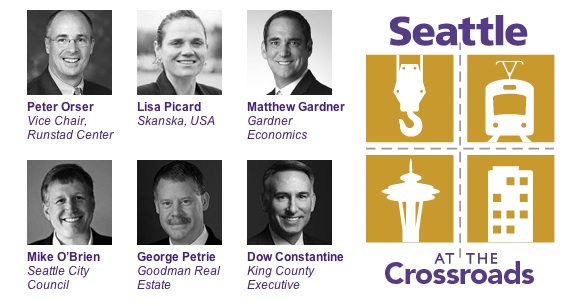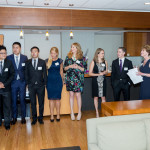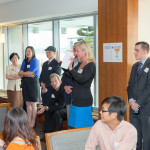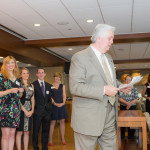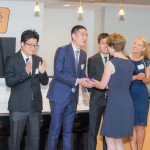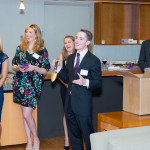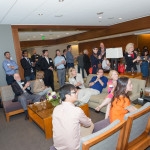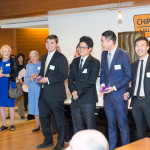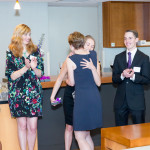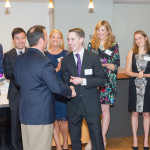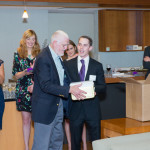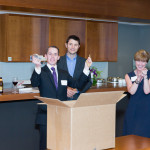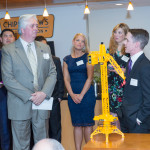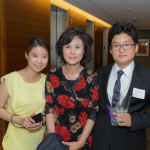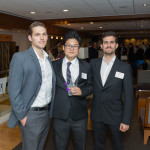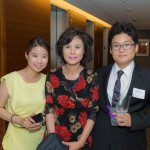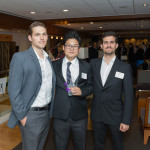The new school year is underway and we are delighted to welcome our newest class of MSRE candidates. Stay tuned for more pictures and updates from the Class of 2016!
Category: News
Orientation is underway!
The Runstad Center welcomed its newest class of MSRE candidates this week! Orientation activities began on Monday, with a full schedule each day until classes begin next week. Our students were introduced to our dean, faculty members, support staff, mentors, and professional community. On Tuesday they toured the Seattle regional real estate market with visits to downtown Seattle, South Lake Union, and Bellevue. Today, they are getting familiarized with our core curriculum and meeting the second year students, who will give them the inside scoop about life in the MSRE program. Later this afternoon, it’s back downtown for several key meetings in the real estate community before kicking back at an Alumni Happy Hour this evening. Tomorrow, off on a ferry boat to explore sustainability and innovation on Bainbridge Island. And that’s just the first few days! More to come… stay tuned for photos from this week, and news about what’s next.
All of us at the Runstad Center extend a very warm welcome to the class of 2016!
Please join us for the first annual Runstad Center Leadership Dinner!
The first annual Runstad Center Leadership Dinner will be held on October 9, 2014, at the Westin Hotel in downtown Seattle. Together with a distinguished panel of public and private leaders, we invite you to join the conversation on the future of our city, region and state.
Special Presentation: Announcing the Glenn Crellin Research Scholarship in honor of Glenn’s twenty-two years of outstanding public service to the state of Washington.
Please visit our event page for more information. Click here to buy a ticket or a table. (RSVP deadline is October 5.) If you are unable to attend but would like to make a contribution, please visit this page.
We look forward to seeing you on October 9!
Washington housing market improves in 2nd quarter of 2014
Washington State’s housing market showed improvement over its first quarter performance, according to a new report from the Washington Center for Real Estate Research here at the Runstad Center. However, year-over-year sales activity is still down across the state.
Runstad Center director Stephen O’Connor explains that while most economic statistics are reported at seasonally adjusted annual rates, these are not forecasts of future activity. He further discussed the Center’s findings with UW Today.
Here’s a preview of the data, in our Q2 2014 Snapshot. The full report, now available to subscribers, will be posted online when the third quarter report snapshot is released. If you’d like to become a subscriber, please contact wcrer@uw.edu.
Runstad real estate research roundup
The Runstad Center has been in the news lately, having released new statistics about record-setting median home prices in Seattle, as well as increased housing vacancy rates in the Tri-Cities. Glenn Crellin talked with KOMO News and the Tri-City Herald about the Center’s findings.
Additionally, Runstad Center Affiliate Fellow and faculty member AP Hurd has an article in CityLab about how outdated parking laws price families out of the city.
On a smaller community scale, M.Arch/MSRE ’13 alum Michael Kaiser is leading an effort to bring a “parklet” to life in the Uptown neighborhood of Seattle. A parklet transforms a small portion of the right of way into a pocket of public park space. They’re almost halfway to their fundraising goal… contributions large or small can be made by following the link here.
Touchstone preparing to start NorthEdge complex in Fremont
Touchstone Corp. is getting ready to start construction on a four-story, 210,000-square-foot office project across the street from Gas Works Park. This is just steps away from the site that our victorious 2014 NAIOP studio team explored in this year’s challenge, solidly in the middle of the “intellectual triangle” formed by the technology/corporate/scholarly hubs of Fremont, South Lake Union, and the University of Washington. Compare the two visions and hear what Runstad affiliate faculty member AP Hurd has to say about Touchstone’s plans for the site in this article from the DJC.
2013 Affiliate Fellow Lisa Picard on Urban Resiliency
“Today, the best lessons about urban resiliency appear to be found in Berlin and Detroit. These cities, both formerly wealthy manufacturing centers, have undergone economic ruin, population decimation and, now, phases of creative and economic re-emergence, fueled by grassroots community movements and entrepreneurial new arrivals.”
2013 Runstad Center Affiliate Fellow Lisa Picard is featured in this month’s issue of ARCADE, with a piece titled “Build Dynamic, Co-Created Plans and Stir the Soul:
Urban Resiliency in Detroit and Berlin.” The 2013 class traveled to these cities (along with Krakow, Poland) and explored the role of commerce as a catalyst to human connection in urban communities amidst economic, political, and natural destruction. Through travel, observation, interviews, and local discussions around commerce as an experience fostering positive social experience, the Fellows sought to build an understanding of the conscious and unconscious patterns that foster urban vibrancy; specifically thriving communities, even amidst adversity. Read Lisa’s full article here!
Congratulations, MSRE Class of 2014!
Our 2014 graduating class of Master of Science in Real Estate students celebrated in grand style last week, prior to receiving their diplomas from the University of Washington.
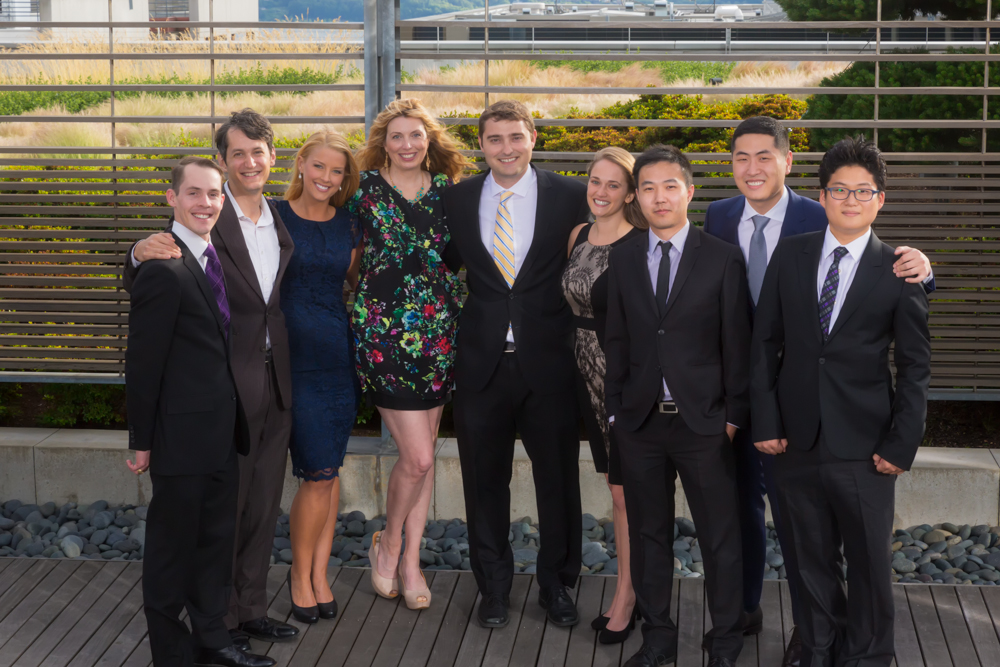
More photos from our festive graduation reception are posted below. Thank you to all the many board members, faculty, staff, family members, and friends who came out to celebrate our students! All of us at the Runstad Center offer them our heartiest congratulations. We know you are destined for stellar careers of leadership and service… stay in touch!
Mobility = Mobility (Part 2)
The previous entry from the Runstad Fellows looked at how an innovative city in Colombia – Medellin – has remade itself through a series of mobility-centered design interventions. The result of these interventions has created a well-connected city, provided better access to jobs, and decreased violence.
Seattle doesn’t have warring neighborhoods or broad swaths of informal settlements, but with the current transit funding gap, a recent proposal for gondolas, and debates about equity in Seattle, Medellin provides more parallels than one might initially think. So what could a Medellin-style mobility strategy look like for Seattle?

For one, it likely would not include reduced transit service. The residents of King County have spoken in the recent Proposition 1 vote, and they have chosen not to bridge the funding gap that King Country Metro has said is necessary to continue transit service at its current levels. This creates a scenario that has disproportionate effects on low-income and disabled citizens. For example, suggested night service cuts won’t affect a large number of people, but it will affect those who rely on public transit to work a night shift. Elimination of routes and reduction of frequency can be mitigated by some through the use of services like Car 2 Go and Lyft, but these aren’t affordable options for some in the city. Furthermore, as more people turn to cars in lieu of public transit, Seattle can expect more congestion on its roadways, which leaves less time for working and living life. Increasing transit routes and frequency allows people to have better access to jobs, spend less time in traffic, and spend less income on transportation. Medellin has made a concerted effort to improve transit access through a variety of options (light rail, BRT, gondolas, bus, etc.), and its residents have benefited from this investment.
Increased mobility would also change the dynamics of Seattle’s housing discussion. Currently, the discussion centers on providing affordable housing in close proximity to good jobs – Downtown and South Lake Union. This is a noble goal, but it requires spending precious affordable housing dollars where land and construction costs are most expensive. Because this money pool is finite, dollars spent on affordable housing Downtown do not go as far as they do in a place like Roosevelt or Beacon Hill. One of the fellows points out that this strategy is like feeding 2 friends with filet mignon as opposed to 8 friends with roasted chicken. A Medellin-style mobility strategy would open the possibilities to creating housing outside of these high-cost areas while still providing excellent access to jobs. The dynamics of housing (affordable and market-rate) change when a city has access to high quality transit and does not have to fight for well-located land. Would an investment in transit create net savings for a city when accounting for the cost of housing? That is a blog post of its own, but it is a question worth exploring. Any data nerds out there?
Finally, another mobility issue facing Seattle is working with what we have…or don’t have. In Medellin, effort was made to allow existing neighborhood centers to integrate with new transit centers. For example a new gondola station integrated with a new public library project, and both were located within a preexisting neighborhood commercial center. In Seattle, investments in infrastructure often miss the opportunity to overlap with existing neighborhood centers. Take the Columbia City Light Rail Station for example. The station is blocks from the true heart of Columbia City. This doesn’t make the station useless, but it does miss opportunities for synergy that were evident in Medellin. It also makes for a lot of incomplete neighborhoods. This means transit centers (i.e. Beacon Hill Station or Northgate Transit Center) often lack essentials like jobs, grocery stores, childcare, etc., while neighborhood centers, which have many of those things, often lack mobility. It takes all of these to have a truly complete neighborhood. Obviously, there are hurdles with developing new transit centers in existing neighborhood centers – namely, purchasing the Right of Way, but as Seattle looks at future reorganization and/or expansion of its transit network, it should view transit centers and neighborhood centers as one in the same.
Seattle and Medellin are not exactly identical twins, but there are still many similarities when it comes to transportation and mobility. When it comes to building a world class city that is livable and accessible for all, Medellin provides some great examples for Seattle to follow. If done right, Seattle could one day have the type of transit-rich, interconnected city the Fellows saw on our trip to Colombia.
Executive Q&A with Greg Johnson
Runstad Center advisory board member (and former chair) Greg Johnson was profiled in Seattle Business magazine this week. In the article, Greg shares his vision for the Spring District as one more place where Seattle’s Eastside can bloom. He also shares a bit about his history prior to becoming President of Wright Runstad & Co., offers his thoughts about new development, and explains a few of the things Seattle that must do to build a solid foundation for the future.

